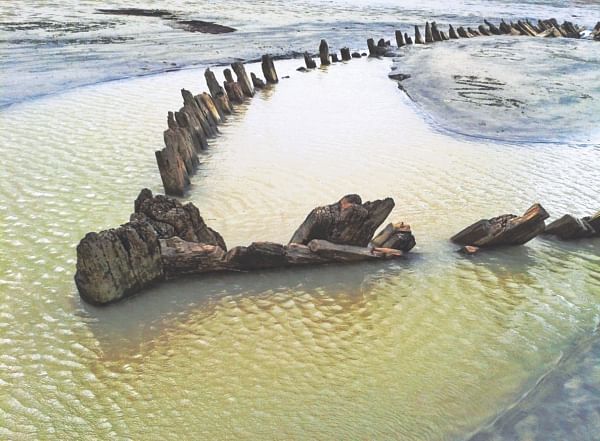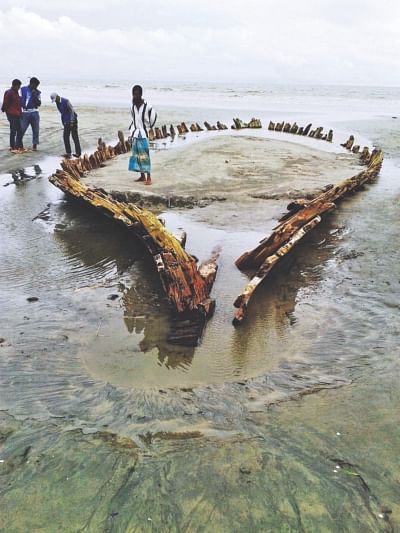| Home - Back Issues - The Team - Contact Us |
 |
| Volume 11 |Issue 49| December 14, 2012 | |
|
|
Endeavour
Salvaging the Kuakata Historic Boat Morshed Ali Khan Word of mouth goes in Kuakata that about 25 years ago a father and son from Musullipara village went into the deep forest of Gangamati by the Bay of Bengal to collect fuel wood. At one point the duo felt thirsty. Customarily both started to dig the sandy surface with their hands and soon hit something hard. As they removed the sand over a small area, they sensed that they hit something precious for the emerging wooden structure glittered with golden decorative sheets. The duo, with their wood cutting machete dismantled the golden bits and then started to dig further for more. The more they dug, more of the metals emerged from what it looked like a very large wooden boat buried under the sand. As the sun was about to set, both decided to call it a day and left the place promising to return early morning the following day. But the daylight never came for the father and son. During the night both died under mysterious circumstances, prompting widespread gossip. Soon people learnt about the buried boat in the forest laden with gold. The unexplained deaths of the father and son, who had collected “gold” from the mysterious boat, triggered another rumour suggesting that the boat was cursed and haunted. Till today many people in Kuakata believe that anyone trying to explore the gold-laden boat would face the same fate of the father and son. This time, superstition probably saved the ancient relic from being plundered. On June 29 the low tide first exposed the boat on the beach near Gangamati.
Experts from Dhaka and the Department of Archaeology examined the 72 feet long and 22.5 feet wide boat, bulk of which still remained buried, and declared that the boat had a historic significance. They said the shape and make of the boat were unique in nature and none among the elderly population of Kuakata or elsewhere could recall having seen such a boat in this part of the country. Yves Marre, a French-born Bangladeshi and the initiator and curator of a traditional boat museum under the banner “Protection and Preservation of National Naval Heritage of Bangladesh, said that close examination of the boat reveals that it is a very unusual boat in this region. “Reports suggest that it is a boat used by the first Rakhaine settlers who escaped from war-torn Myanmar over 200 years ago. It is a treasure that must immediately be protected and preserved,” Marre said. There may be other suggestions too. Some believe it could belong to the era between 1442 and 1449 when the sixty-dome mosque was built in Bagherhat. Real Admiral (retd) A Taher, also former naval chief, said that the boat could have been used for carrying stones to Bagherhat from Burma. Yves suggested “carbon dating” to determine the actual age of the boat. “Such kind of surfacing of an ancient boat does not happen every day in maritime history so we have to explore all possibilities of preserving its history,” he added. Uchasi Matubbar, 70, a leader of the Rakhaine community in Kuakata, said that over 150 Rakhaine families had come to the area, fleeing atrocities in Myanmar in 1784. "Those people on 50 boats fled the torture of Bodpaya who had defeated the king of Arakan province Thamada and had taken over power. This boat might be one of those," said Uchasi. The government must take immediate steps to protect and preserve it in a museum in Kuakata, he added. How the boat got there, was one of the questions asked by everyone, including the experts. The most credible answer was that hundreds of years ago the sea was miles away from the forest, which only the other day was teeming with ferocious wildlife. Through the forest came a canal flowing into the sea, in the same way river Gangamati today meets the sea near the wreck. Whoever used the boat, moored it safely inside the canal and left the area fearing the ferocious animals around them. With big cyclones and tidal surges the boat got buried under the sand. Dr MM Hoque, professor at the Department of Archaeology, who is also assisting in salvaging the boat, corroborated with the suggestion. Having inspected the boat he said that the boat's current north-south position indicates that it was moored when it was engulfed by the sea and buried. On November 6, the Ministry of Cultural Affairs formed a committee, headed by the Director General of the Department of Archaeology. It comprised, including this writer, nine members. The others are Yves Marre, former naval chief Real Admiral A Taher, Deputy Commissioner and Police Superintendent of Patuakhali, Chairman of Jahangirnagar University's Depertment of Archaeology, a deputy secretary from the ministry and an assistant director of the Dhaka division regional office. On November 24 the committee members visited the sight of the ancient boat in Kuakata along with local administrators to chalk out a salvage strategy. They formed a technical committee, headed by Yves Marre, and decided to dig out the ancient boat within mid February. “The excavation work will start on December 23 and we shall do whatever we can to bring out the boat and display it in Kuakata in a proper way,” said Shirin Akhtar, the Director General of the Department of Archaeology. The writer is Special Correspondent, The Daily Star.
Copyright
(R) thedailystar.net 2012 |

